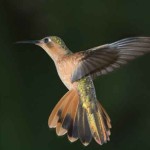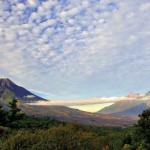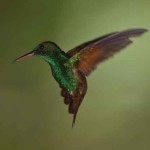El Pilar
photos by Thor Janson
Experimenting with a Vision
The second of a three-part series exploring El Pilar, home to a large diversity of animal and plant life—much of which remains to be discovered and researched.
The vision for transforming Finca El Pilar into a protected natural reserve is something of an ongoing experiment. Manager Juan Rivera says constructing a haven for hummingbirds, with a row of artificial feeders along with a specially designed garden, was among the first infrastructures tested on the farm.
“Before I installed them I went to the Internet and started to research… . I found a study a woman made in the United States and she had 20 years of experience with hummingbird feeders in her back yard. She said that you should only use white sugar. You should not buy the kits with the red coloring because she said that maybe they can cause cancer. In lab rats it has caused cancer.”
Guide Moisés Batres Morales says the farm now uses four liters of the white sugar “honey” every day, successfully attracting Guatemala’s most endemic species of hummingbirds. Rivera explains that both the artificial and natural nectar create a “fueling station” of sorts, offering an ideal environment for observation.
“The nectar is like fuel, so they can go and catch some insects. They eat insects. So when you see they are flying all around, they are actually catching little insects. … The hummingbird Rufous Sabrewing, this is a hummingbird that is endemic. They are only found in Guatemala and the southern part of Mexico. So you can see this hummingbird very easily here. [Just now] it has passed maybe eight times.”
Birdwatchers can venture farther into the reserve to observe more than just hummingbirds. Over 130 bird species are found throughout the grounds.
The misty slopes of El Pilar, less than 4 kilometers from La Antigua’s central park, are still shrouded in mystery. Rivera says the extent of biodiversity within the natural sanctuary has yet to be discovered, and it is that abundant biodiversity that compelled Rivera to begin experimenting with transforming El Pilar’s untouched terrain into a natural reserve.
“This is like an abandoned plantation.”
“A few months ago we had a student from the University of San Carlos who was studying bats. He was doing a comparative analysis of all the coffee farms of Antigua as well as farms that had both coffee and forest like us. What he found he only told me orally: that this was one of the most diverse places of bats he found all over Antigua, because of all the forest that we have. The other coffee farms were less diverse because they grow just coffee and some shadow trees.”
Rivera is eager to continue discovering the farm’s rare and unique habitat. But, he explains, such exploration requires sustainable funding.
“You can’t make conservation without making any money, so one of the ways of making money is through tourism. That’s why we started building all of this infrastructure to have tourists here, show them how beautiful it is and maybe have some revenue to invest in the conservation.”
Rivera says he has already begun reforesting parts of the farm that have unfortunately been destroyed.
“A long time ago they cut the forest; some fragments were cut. So we are starting to grow trees again, to rebuild the eco-system.”
Future projects that interest Rivera include investigating the populations of beetles and nocturnal butterflies found on the farm.
Nature enthusiast and well-known photographer who specializes in capturing Central America, Thor Janson, says “Reserve projects like that of El Pilar are part of a yet bigger, global project. It’s an experiment, a vast experiment we’re conducting on Earth. James Lovelock points out in his last book, Revenge of Gaia, that it’s too late for business as usual. It’s too late for sustainable development. What is required is sustainable retreat. What that means is right now we have to stop cutting down forests, completely stop cutting down more forests, and begin reforesting the whole Earth.”
While Finca El Pilar is not a project that will change the world, for Rivera it can certainly offer an ecologically sound, beautiful place to visit.
“There are so many tourists that come to Antigua and want to go to a place where you can enjoy nature without having any danger.”
El Pilar is located about 3.5 kilometers from the central park. Begin by walking south toward 7a calle until you reach San Francisco Church. Walk past the church and behind it to find the path leading to Santa Ana. Look for El Calvario Church and INVAL, the institute for men. When you reach the landmarks, cross to the left to find the end of a path. You will be able to see the Church of San Cristóbal El Bajo. Walk up the path, past the church until you reach El Pilar. The walk is about 20 minutes. A ride in a tuk tuk or taxi will take less than 10 minutes.



Do you have an e/mail for Juan Rivera, who is quoted in this article? I met him yesterday when I visited El Pilar (which is beautiful) and I would like to start refering my travel clients to him. Thank you. George Sansoucy of Antigua
Pingback: Simply Complicated » Blog Archive » Weekend Family Hike